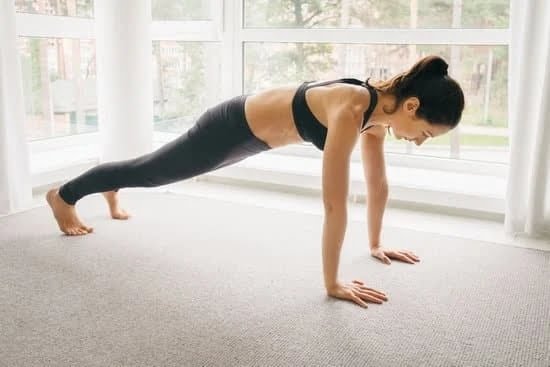Are you looking for a way to get fit in just one month without traditional exercise? In this article, we will explore the concept of achieving fitness goals through alternative methods that do not involve regular workouts at the gym. While exercise is a crucial component of a healthy lifestyle, there are other factors and techniques that can help you improve your overall fitness level and achieve your desired results within a short time frame.
When it comes to getting fit without exercise, it’s essential to set realistic goals and understand the potential limitations and results of a no-exercise fitness plan. We will discuss the importance of having achievable expectations and how certain lifestyle changes can contribute to reaching your fitness goals without conventional physical activity.
One key aspect we will delve into is the role of diet and nutrition in achieving fitness goals without exercise. Creating a balanced and healthy meal plan to support weight loss and muscle toning can be highly effective in improving overall fitness. Additionally, we will explore the benefits of intermittent fasting for weight management, as well as incorporating daily movement, staying hydrated, managing stress, and optimizing rest and recovery for a healthier lifestyle.
Setting Realistic Goals
When seeking to get fit in 1 month without exercise, it’s important to set realistic goals and have a clear understanding of what can be achieved within this time frame. While traditional exercise may not be part of the plan, it is still possible to make significant improvements in overall fitness, body composition, and health. It’s essential to acknowledge that without regular physical activity, the results may be more modest compared to a fitness routine that includes exercise.
Limitations of No-Exercise Fitness Plan
Lack of Cardiovascular Improvement
One key limitation of a no-exercise fitness plan is the lack of improvement in cardiovascular health. Aerobic exercise is essential for strengthening the heart and improving lung function, which are crucial for overall fitness and well-being. Without traditional exercise, achieving significant cardiovascular improvements within a month may be challenging.
Moderate Muscle Toning
Another limitation is the potential for moderate muscle toning. While it’s possible to make some progress in muscle definition and tone through activities like daily movement and bodyweight exercises, the results may not be as substantial as those achieved with regular resistance training.
Potential Results of No-Exercise Fitness Plan
If approached with realistic expectations, a no-exercise fitness plan can still yield positive results within a month. By focusing on nutrition, hydration, stress management, and other lifestyle factors, individuals can experience weight loss, improved body composition, increased energy levels, and better overall health.
By understanding these limitations and potential results, individuals can set achievable goals and tailor their approach to getting fit in 1 month without traditional exercise. The key lies in creating a comprehensive plan that encompasses multiple aspects of lifestyle and health management while staying consistent and dedicated to making positive changes.
Diet and Nutrition
In order to get fit in 1 month without exercise, it’s crucial to focus on diet and nutrition. While traditional exercise is not part of this plan, creating a balanced and healthy meal plan can support weight loss and muscle toning. This means paying attention to the types of food consumed, portion sizes, and meal timing.
To start, it’s important to include a variety of nutrient-dense foods such as fruits, vegetables, lean proteins, whole grains, and healthy fats in your meal plan. These foods provide essential vitamins and minerals that support overall health and well-being. Additionally, they can aid in weight management and muscle toning when consumed in appropriate amounts.
Portion control is another key aspect of creating a balanced meal plan without exercise. By being mindful of portion sizes, individuals can avoid overeating and consume calories that are more in line with their fitness goals. Using smaller plates, measuring portions, and practicing mindful eating can help with portion control.
Finally, meal timing can play a role in supporting weight loss and muscle toning without traditional exercise. Some people find success with intermittent fasting as a way to manage calorie intake and promote fat loss. This approach involves cycling between periods of eating and fasting, which may lead to improved metabolic health and weight management.
| Dietary Component | Importance |
|---|---|
| Nutrient-dense foods | Provide essential vitamins and minerals for overall health; support weight management |
| Portion control | Prevents overeating; helps manage calorie intake for weight management |
| Meal timing (intermittent fasting) | Promotes fat loss; improves metabolic health |
Intermittent Fasting
- Weight loss: Intermittent fasting can help you achieve weight loss by reducing calorie intake and increasing the body’s ability to burn fat for energy. During the fasting period, the body shifts from using glucose as fuel to burning stored fat, which can lead to significant weight loss over time.
- Improved metabolism: Intermittent fasting has been shown to improve metabolic health by increasing insulin sensitivity, reducing inflammation, and promoting cellular repair processes. This can result in better regulation of blood sugar levels and overall improved metabolic function.
- Health benefits: In addition to weight management, intermittent fasting has been linked to various health benefits such as reduced risk of chronic diseases, improved heart health, and enhanced brain function. By giving the body a break from constant eating, intermittent fasting allows it to focus on repair and maintenance, leading to overall improved health.
When exploring how to get fit in 1 month without exercise, incorporating intermittent fasting into your routine can be a valuable tool for achieving your fitness goals. However, it’s important to consult with a healthcare professional before starting any new diet or fasting regimen to ensure it is safe and appropriate for your individual needs.
Daily Movement
Incorporating daily movement into your routine is a key component of getting fit in a month without traditional exercise. While you may not be hitting the gym for intense workouts, small, low-impact activities can still make a big difference in calorie burning and overall fitness.
One way to do this is by taking regular walks throughout the day. Walking not only burns calories but also improves cardiovascular health and helps with stress management, which are all essential for achieving fitness goals.
Another way to incorporate daily movement is by integrating stretching or yoga into your morning or evening routine. These activities help improve flexibility, relieve tension in the muscles, and promote relaxation. Additionally, household chores such as vacuuming, gardening, or cleaning can also contribute to calorie burning and increased movement throughout the day.
Making simple changes like taking the stairs instead of the elevator or parking further away from your destination can also add up in terms of physical activity. These small adjustments may seem insignificant, but over time they can contribute to improved overall fitness. By finding creative ways to stay active throughout the day, you can support your fitness goals even without traditional exercise.
| Low-Impact Activity | Calories Burned (Per Hour) |
|---|---|
| Walking | 150-300 |
| Yoga | 180-300 |
| Cleaning | 200-300 |
Hydration
Staying properly hydrated is essential for maintaining good health and achieving fitness goals, even without traditional exercise. Here are some tips for understanding the importance of hydration and its impact on weight loss and overall health:
- Drink plenty of water: One of the simplest ways to stay hydrated is by drinking enough water throughout the day. Aim for at least 8-10 glasses of water daily, and more if you live in a hot climate or engage in physical activity.
- Monitor your urine color: One way to gauge your hydration levels is by paying attention to the color of your urine. Clear or light yellow urine indicates that you are well-hydrated, while dark yellow urine may signal dehydration.
- Include hydrating foods in your diet: In addition to water, you can also consume fruits and vegetables with high water content, such as cucumbers, watermelon, oranges, and strawberries.
Proper hydration plays a crucial role in weight loss efforts. When you are well-hydrated, it can boost your metabolism and help with fat burning. Additionally, staying hydrated can help reduce feelings of hunger and prevent overeating. Dehydration can often be mistaken for feelings of hunger, leading to unnecessary snacking and calorie consumption.
Moreover, maintaining proper hydration levels is important for overall health. Water helps regulate body temperature, aids in digestion, flushes out toxins, and keeps joints lubricated. Dehydration can lead to various health issues such as headaches, dizziness, fatigue, and kidney stones. By prioritizing hydration as part of a no-exercise fitness plan, individuals can support their weight loss journey while also promoting overall well-being.
Stress Management
Understanding the Link
Stress can have a significant impact on weight gain. When we are stressed, our bodies release cortisol, which can increase our appetite and lead to overeating. Additionally, stress can also lead to emotional eating, causing individuals to seek comfort in food as a coping mechanism. This can result in consuming more calories than necessary, leading to weight gain over time. Understanding this link is crucial for anyone looking to get fit in a month without traditional exercise.
Implementing Stress-Relief Techniques
To combat the impact of stress on weight gain, it’s essential to implement stress-relief techniques into your daily routine. Techniques such as mindfulness meditation, deep breathing exercises, yoga, and spending time in nature can help reduce stress levels.
Additionally, engaging in hobbies or activities that bring joy and relaxation can also be effective in managing stress. By incorporating these techniques into your daily life, you can reduce the likelihood of stress-induced weight gain and support your fitness goals.
The Importance of Mental Well-Being
In addition to implementing stress-relief techniques, prioritizing mental well-being is also important for achieving fitness goals without traditional exercise. Seeking support from friends, family, or a mental health professional can provide valuable tools for managing stress and improving overall mental well-being. By addressing the underlying causes of stress and finding healthy ways to cope with it, individuals can create a healthier lifestyle conducive to meeting their fitness objectives.
Overall, managing stress is a crucial aspect of getting fit within a month without exercise. By understanding the link between stress and weight gain, implementing stress-relief techniques, and prioritizing mental well-being, individuals can create a foundation for success in their fitness journey.
Rest and Recovery
In conclusion, achieving fitness goals in a month without traditional exercise is possible by focusing on other aspects of health and wellness. By setting realistic expectations and understanding the limitations of a no-exercise fitness plan, individuals can effectively work towards their desired results. Through a combination of dietary changes, intermittent fasting, daily movement, hydration, stress management, and prioritizing rest and recovery, significant improvements in weight loss and muscle growth can be achieved.
A key factor in this approach to fitness is creating a balanced and healthy meal plan that supports weight loss and muscle toning. By incorporating nutrient-dense foods and practicing intermittent fasting, individuals can optimize their body’s natural processes for weight management. Additionally, staying hydrated and integrating small, low-impact activities into daily routines further promotes calorie burning and overall fitness. These lifestyle changes are crucial in achieving the desired results within a short timeframe.
Furthermore, emphasizing the importance of rest and recovery cannot be overstated. Optimal sleep quality is vital for both weight loss and muscle growth.
By implementing stress-relief techniques and prioritizing adequate rest, individuals can maximize the benefits of their no-exercise fitness plan. Ultimately, while traditional exercise may not be feasible for some individuals within a one-month timeframe due to various reasons such as injury or time constraints, this holistic approach offers an alternative path to achieving fitness goals effectively.
Frequently Asked Questions
Can You Get in Shape in 1 Month?
Getting in shape in one month is definitely possible, but it depends on your starting point and how much effort you’re willing to put in. You’ll need to focus on both diet and exercise to see significant changes in such a short timeframe.
Can You Be Slim in 1 Month?
Achieving a slimmer physique in just one month is also possible, but it may require making significant changes to your diet and exercise routine. It’s important to set realistic goals for yourself and understand that sustainable weight loss takes time.
How to Lose 10 Pounds in 2 Weeks Without Exercise?
Losing 10 pounds in two weeks without exercise is a challenging goal, but it can be achieved through strict calorie restriction and a focus on eating whole, nutrient-dense foods. However, it’s important to keep in mind that rapid weight loss may not be sustainable or healthy in the long run.

Passionate about providing useful information to anyone with an interest in the field of Personal Training, I strive to pass on to our readers quality information and to answer any questions about Personal Trainers, the work they do and how to become one.





